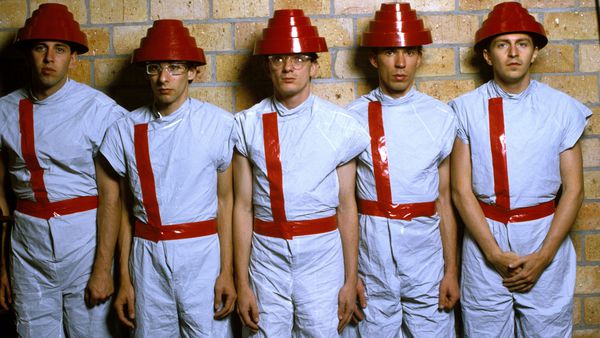Eye For Film >> Movies >> Devo (2024) Film Review
Devo
Reviewed by: Jeremy Mathews

When Devo comes to mind, the band’s iconic visuals appear just as fast as the electronics-infused rock and roll: wedding-cake shaped “energy dome” hats, industrial yellow jumpsuits, the satirically over-the-top Americana of the Whip It video. When you mingle these visuals with the classic songs and the deeper motivation beneath the surface, a documentary about the band seems like a no-brainer.
Chris Smith’s film is very much what you might expect and hope for from a Devo documentary, while also being highly informative and entertaining. It tells the story of the band’s origins, its most iconic output and the output made as the project declined.

The band – and the art project that lead to it – formed in Ohio at Kent State University in 1970 in the midst of the Vietnam War protests and the police shooting on campus that killed four and injured nine. Starting as a project between art students Gerald Casale and Bob Lewis, the band eventually became based around its core paid of brothers, Mark and Bob Mothersbaugh and Gerald and the late Bob “Bob 2” Casale, who died in 2014.
While the band was often considered a novelty act, its core was more subversive and satirical, with its heart being the theory of de-evolution: the belief that man is no longer evolving but regressing in a society that makes you stupider. The band was basically an exercise in taking the piss out of corporate culture. And as long as they had the potential to make money, they more or less got away with it.
Smith premiered the film at the 2024 Sundance Film Festival, on the 25th anniversary of his breakout hit American Movie, which won the US Documentary Grand Jury Prize. As far as format and content go, the two films are a long distance from each other. The earlier effort was about a struggling ultra-low-budget filmmaker, and featured mostly material shot by Smith. This new one is a career retrospective of a highly influential (if not always financially successful) band, that is most impressive for distilling mountains of archival footage, with the help of the trusty talking-head interview.
When depicting a band’s early years, most documentaries have to rely on a few archival photos and some generic B-roll to fill in the gaps. But Smith and his team had an embarrassment of riches for every step of this documentary. Since Devo started as a performance art project with a strong interest in film and video, there’s footage of everything, including the band’s aggressively noisy, tuneless and songless debut performance.
Devo tells the band’s story more or less chronologically – a choice with pluses and minuses. On one hand, there’s no feeling like the filmmakers are employing a structural gimmick simply to prove how clever they are. On the other, the narrative can begin to feel like a laundry list, especially after the band’s initial formation period ends and we start the professional cycle of writing and recording albums. Edgar Wright’s recent The Sparks Brothers (2021) particularly suffered from this syndrome. And there’s also the fear of “How do we make this seem like something other than a long Behind The Music episode with less time in rehab?”
Smith’s answer is to let the work speak for itself. And Devo’s remarkable body of film and video work means it can. This is not simply cool videos. Devo made sketches in which comedic record company executives tried to bend them to their will. They begged for money to make music videos, a particular passion of Gerald’s, which eventually put them on the map when a nascent MTV was hungry for content. They were even ahead of their time with synchronised video and lighting in live performances, something that is now a part of almost every major tour.
At Sundance, Smith said his visual reference for the film’s flow was Devo’s video for the song Beautiful World, which contrasts clips of models and luxury products with those of war, racism and famine in a pulsating, hypnotic manner. And while Devo may not make any particular advances in the band documentary genre, it undeniably has the pulsating, hypnotic quality of its subject’s best work.
Reviewed on: 15 Jun 2024















